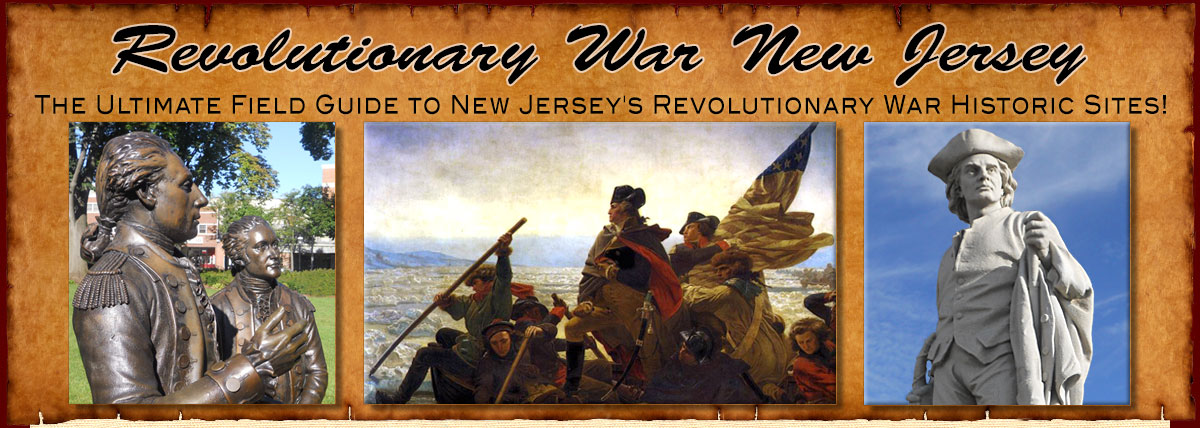

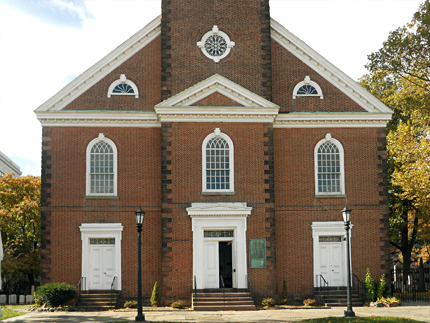
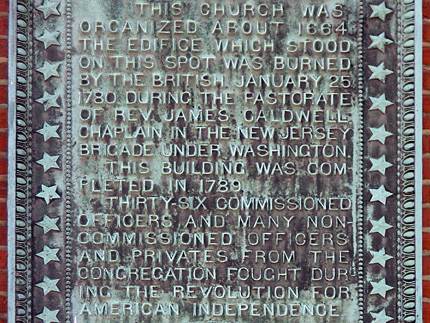
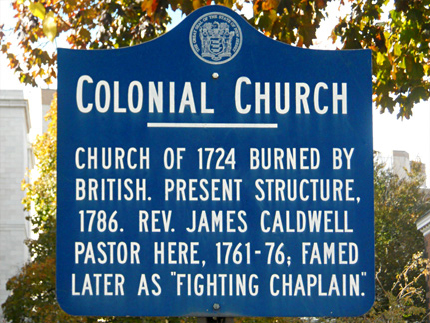
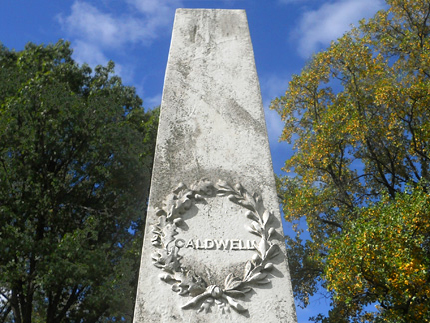
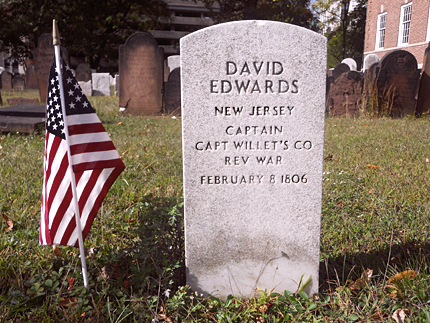
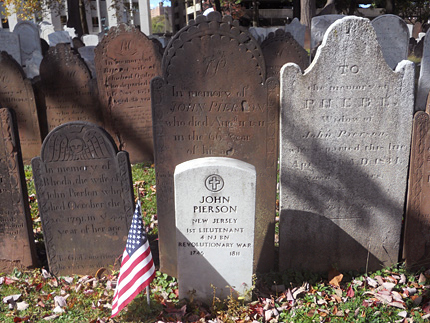
First Presbyterian Church and Cemetery
42 Broad Street
Map / Directions to the First Presbyterian Church of Elizabeth
Map / Directions to all Elizabeth Revolutionary War Sites
Elizabeth has a long and interesting history. It was formed in 1664 under the name Elizabethtown, and it was the first British settlement in what would become the colony and then the state of New Jersey. The original Elizabethtown tract was much larger than the modern city of Elizabeth. Elizabethtown originally contained all of what is now Union County. Beginning in 1794 with Westfield and then Springfield, areas of Elizabethtown broke off to form what eventually would make up the other towns of Union County. The city of Elizabeth was incorporated in 1855. [1]
Please Note: Throughout the entries on this page, both Elizabethtown and Elizabeth names are used, depending on the context.
Because of its geographic location, Elizabethtown was in a dangerous position throughout the Revolution: it is a port city on Newark Bay which flows out to the Hudson River, just miles on the river from Manhattan and Staten Island, which were in the hands of the British throughout the war. This made Elizabethtown a convenient target for raids by the British. The most devastating of these raids occurred on January 25, 1780, when Elizabethtown was attacked by raiding British forces who caused great damage and burned buildings. Amongst the Elizabethtown buildings burned was an earlier Presbyterian Church building that stood in the same location as the current church building. The British forces also burned the Old Academy school and the Courthouse (see the following two entries below). The same day, other British forces raided Newark, which is in a similar geographic position on Newark Bay. Newark's First Academy school was burned in that raid.
Reverend James Caldwell was the pastor at this church. Caldwell had an interesting Revolutionary War history, with connections to a number of historic sites throughout Union and Essex County. When the Elizabethtown church building was burned by British troops on January 25, 1780, the manse where the Caldwells lived was burned as well. (Manse is a term for the house used by a Presbyterian minister.) With their home and church burned, James, his wife Hannah, and their nine children moved to a parsonage in Connecticut Farms (now Union), and James preached at the church there. Sadly, Hannah was killed when she was struck by a bullet fired by a British soldier on June 7, 1780, during the Battle of Connecticut Farms. The same day, the British burned the Connecticut Farms church and the parsonage. Sixteen days later, James took part in the fighting at the Battle of Springfield. On November 24, 1781, just a year and a half after Hannah's death, James Caldwell himself was killed by an American sentry named James Morgan. Morgan was tried at the Presbyterian Church in Westfield, found guilty, and then hanged at Gallows Hill in Westfield. Both James and Hannah are buried here in the Elizabeth Presbyterian Church cemetery. The town of Caldwell NJ is named for James Caldwell, and a boulder monument there pays tribute to him. [2]
Reverend Caldwell was far from alone among the members of this church in his commitment to the cause of Independence. The congregation of the church contained thirty-six commissioned officers, as well as many non-commissioned officers and enlisted men. [3] The cemetery contains the graves of many Revolutionary War veterans, including: [4]
Isaac Arnett
Died Sep, 1801. Age 75
Moses Austin
Nov 10, 1751 - Jul 17, 1827
Private, Essex County Troops
Ezekiel Baker
Died May 15 1810
Jeremiah Ballard
Died Sep 4, 1825
Captain, 2nd Reg., Continental Line
Dr. William Barnet
1728 - Dec 1, 1790
William Britton
1738 - Jul 22, 1783
Captain, 3rd Reg., NJ Militia
William Brown
Died Sep 15, 1817
Johnathan Chandler
Died Feb 9, 1836
Private, NJ Troops
James Chandler
Died Jan 7, 1808
Ichabod Chandler
Apr 7, 1829
Samuel Chandler
1735 - Dec 2, 1804
Stephen Chandler
Died Oct 25, 1800
Private, 1st NJ Reg.
John Chetwood
1736 - Feb 20, 1807
Jacob Crane
Died Jun 11,1817
James Crane
Died Oct 17, 1819
John Crane
Died 7 Apr 1840
Stephen Crane
Oct 14, 1737 - Feb 11, 1796
Private, 2nd Reg., Essex County Militia
Stephen Crane
1709 - July 1, 1780
Served in the Continental Congress
William Crane
Oct 12, 1747 - Jul 9, 1814
Nathaniel Crane
Nov 24, 1762 - Aug 31, 1825
Thomas Crowell
Died Dec 14 1799, Aged 74
Daniel Dayton
1741 - Feb 19, 1808
Ellias Dayton
Feb 4, 1737 - Oct 22, 1807
Jonathan Dayton
1743 - Oct 17, 1794
Captain, 3rd NJ Regiment of Foot
William H. Denman
Died Jul 2, 1847
David Edwards
Died Feb 8, 1806
Captain, Captain Willet's Company
Jacob Foster
Died Mar 11, 1814
John Foster
Died Dec 16, 184l
Rev & 1812
Job Haines
Died May 28, 1807
John Haines
1735 - 1803
Teamster, Capt. Jediah Davison's
Team Brigade
Samuel Halsted
Died Jan 27,1805
Samuel Harriman
Jan 18, 1752 - Aug 21, 1824
Captain, 1st Reg., Essex County Militia
Stephen Harrison
1742 - Dec 22, 1793
Aaron Hatfield
July 30 - May 15, 1839
Josiah Hunt
Mar 18, 1760 - May 21, 1841
Henry Insley
Died Dec 20, 1797
Shepard Kollock
Sep 1750 - Jul 28, 1839
Benjamin Lyon
Died Dec 8, 1803, Aged 49
David Lyon
Died Mar 30, 1802
Matthias Lyon
1738 - Nov 11, 1797
Captain
Michael Magie
Aug 8, 1757 - Jan 6, 1810
Jonathan Meeker
Died Oct 6, 1805
Private, Essex County Militia
Joseph Meeker
Died Oct 23, 1803
Obediah Meeker
1738 - Apr 5, 1829
Captain, NJ Militia
Benjamin Miller
Oct 22, 1731 - Mar 12, 1795
Moses Miller
1741 - Sep 24, 1821
Samuel Morehouse
Mar 6, 1742 - Dec 10, 1790
Benjamin Mulford
1752 - Jul 27, 1840
Private
John Mulford
Died Aug 16, 1815
Private, Essex County Militia
Lewis Mulford
1744 - Feb 17, 1830
Thomas Mulford
Nov 10, 1751 - Dec 31, 1830
Aaron Ogden
Dec 3, 1756 - Apr 19, 1839
1st New Jersey Regiment
Later elected NJ Governor in 1812
John Ogden
Died Jul 25, 1780
Matthias Ogden
Oct 22, 1754 - Mar 31, 1791
Mathias Ogden
Apr 24, 1742 - Mar 7, 1818
Colonel, 1st Battalion, Continental Line
Moses Ogden
Died 7 June 1780, Aged 20 at the
Battle of Connecticut Farms
Ensign, Spencer's Regiment, Continental Army
John N Oliver
Died Nov 11, 1813
Joseph Periam
1742 - Oct 8, 1781
John Pierson
Died Aug 11, 1811
1st Lieutenant, 4th NJ Battalion
Anthony Price
Died Feb, 1807
Farrington Price
Jul 16, 1758 - Dec 18, 1802
George Price
Nov 9, 1763 - Jan 3, 1813
Private, NJ Troops
George Price
1736 - Apr 13, 1811
Nathaniel Price
Died Jan 10, 1809, Aged 75
Ralph Price
Apr 24, 1748 or 1749 - Dec 2, 1815
Private
William Ramsden
1750 - Jan 15, 1807
Private, Captain Marsh's Troop
Tenrub Price
Died Oct 11, 1810
Private
George Ross
1740 - Feb 22, 1794
Ensign, 1st NJ Regiment
Ephriam Sayre
Mar 8, 1746 - Oct 24, 1819
Also served in War Of 1812
William Shute
1726 - Apr 5, 1784
William Shute
Mar 9, 1750 - Aug 12, 1841
William Smith
1742 - Aug 6, 1788
Benjamin Spinning
1746 - Mar 11, 1802
Private, Essex County Troops
Richard Townley
Aug 22, 1736 - Aug 4, 1801
Captain
Abraham Tucker
Died Oct 30, 1792
Charles Tucker
Died Sep 27, 1791
Nehemiah Wade
1736 - Oct 19, 1776
David Whitehead, Jr.
1726 - Apr 22, 1810
Private, Van Cortland's Battalion, NJ Militia
Ephraim Lockhart Whitlock
Sep 22, 1755 -Sep 22, 1825
Lt. Col., 14 Infantry
Benjamin Williams
Died Oct 25, 1785
David Williams
1757 - Aug 1841
William Williams
1747 - Apr 4, 1816
Private, NJ Troops
Aaron Winans
1753 - May 13, 1810
Benjamin Winans
1738 - 1819
Benjamin Winans
1722 - 24 Mar 1793
Elias Winans
Jul 16, 1742 - Feb 12, 1789
John Winans
Feb 2, 1802, Aged 51
Private, Essex County Militia
Moses Winans
Died Jun 26, 1788
Moses Winans
1753 - Jan 28, 1822
Private - Essex County Troops
Private, Essex Troops
Aaron Woodruff
Died Aug 29, 1780
David Woodruff
1746 - Jul 29, 1804
David Woodruff
Died Sep 7, 1822
Daniel Woodruff
1742 - Apr 15, 1812
Private, 2nd Essex Regiment
Ezekiel Woodruff
Sep 13, 1744 - Jan 14, 1802
Job Woodruff
Died Jan 17, 1794
Private, 1st Regiment, Essex County Militia
Thomas Woodruff
1734 - Apr 23, 1805
Adjudant, NJ Milita

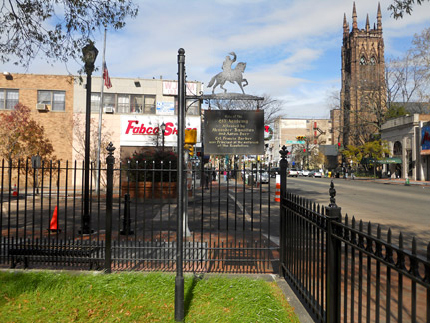
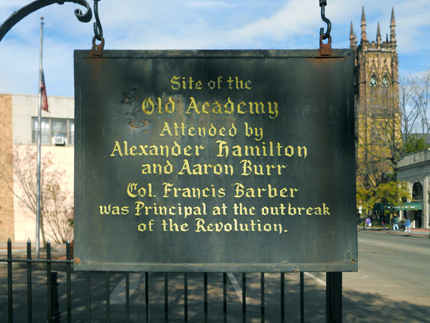
Site of the Old Presbyterian Academy Marker
42 Broad St.
(In front of the Parish house of the First Presbyterian Church)
Map / Directions to the site of the Old Academy
Map / Directions to all Elizabeth Revolutionary War Sites
Where the Presbyterian Church's current Parish House (built 1916) stands was once the site of the Presbyterian Academy, which was burned by British forces along with the Church on January 25, 1780.
The School was attended by Alexander Hamilton and Aaron Burr. Burr attended the school several years before Hamilton. However, Burr spent time in Elizabethtown during 1773 while Hamilton was a student here, so it is possible, but uncertain, that they may have met at that time. [5] Both men would go on to important military and political roles in the Revolutionary War era: Hamilton served as a colonel and aide-de-camp to General Washington in the War, and he later served as the country's first secretary of treasury. Burr also served as a colonel in the War, and he later was the country's third Vice President. In 1804, the two men would meet in Weehawken for the famous duel that ended the life of Alexander Hamilton.
The Academy's principal at the beginning of the Revolution was Francis Barber. Barber served as a lieutenant colonel in the Revolutionary War. [6] Barber lost his life in an unusual accident that occurred in 1783. He was riding on horseback to dine with General Washington, who was headquartered in Newburgh, New York. He passed by some men who were cutting down trees, and he was hit and killed by one of the trees. Upon receiving the news of Barber's death, Washington is reported to have said, "Men of higher rank and more wealth may die, but there is but one Francis Barber." [7]
Francis Barber lived in the Bonnell House in Elizabeth. (See Bonnell House entry lower on this page.)

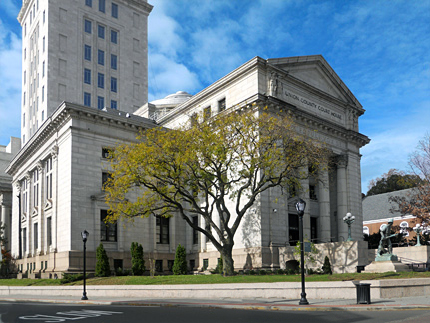
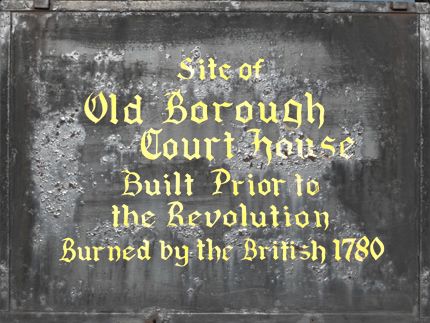
Union County Courthouse
2 Broad St.
Map / Directions to Union County Courthouse
Map / Directions to all Elizabeth Revolutionary War sites
In front of the courthouse is a sign marking the site of the Old Borough Courthouse, which was burned by British forces in the same January 25, 1780 raid when they burned the Presbyterian Church, manse, and the Academy.[8]
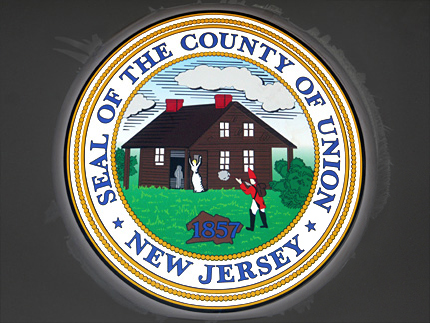
Union County Seal
The photo at left shows the Union County seal as it appears over the entrance to the Union County courthouse. The seal depicts the killing of Hannah Caldwell, the wife of Reverend James Caldwell who had been the minister of the First Presbyterian Church of Elizabeth. After the British burned the church and the Caldwell's house, the family moved to Connecticut Farms (now Union).
Hannah Caldwell was shot and killed by a British soldier at the house during the Battle of Connecticut Farms. The image on the seal takes liberties with the story, as it shows a British soldier deliberately gunning down Hannah Caldwell standing outside of the house, when in reality she was shot through a window by a soldier who probably mistook her to be a sniper. This may be the only town, county, or state seal in the United States that depicts a killing. [9]
For more about the death of Hannah Caldwell, see the Caldwell Parsonage entry on the Union Page.
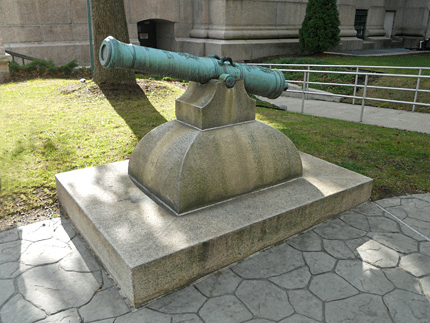
Revolutionary War Cannon
There is a Revolutionary War cannon in front of the courthouse. A plaque at the site explains the history of this cannon: [10]
"This gun, cast in Strasburg in 1758, was sent by Louis XV, King of France, to Canada for the defense of Quebec. Upon the surrender of that place in the following year, the gun fell into the hand of the British. In April, 1760, the French recaptured the gun, and in May the British re-took it. In the fall of 1775 this gun aided in the repulse of the Continental force under General Richard Montgomery, who was mortally wounded while attempting to capture it. In June 1779, Sir Henry Clinton captured Stony Point, and a month later General Anthony Wayne re-took it finding this gun among the trophies. General Washington presented the piece to troops from Elizabethtown who had acted as a reserve and it was brought here by them soon after."

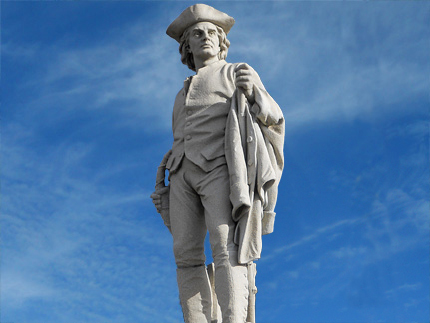
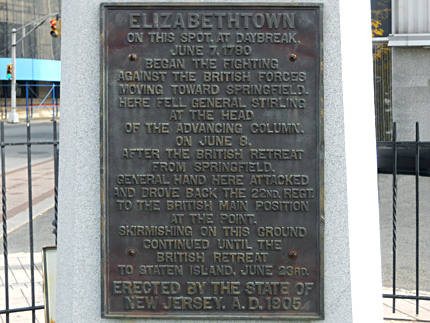
Minuteman Statue
Elizabeth Ave. and High St. (Union Square)
Map / Directions to the Minuteman Monument
Map / Directions to all Elizabeth Revolutionary War Sites
Half a year after the raid that burned the church, manse, academy, and courthouse, Elizabethtown was invaded by British and Hessian forces as part of two attempts at attacking Washington's forces encamped at Morristown. Their plan was to land in Elizabethtown from Staten Island, and then make their way west across New Jersey, through the villages of Connecticut Farms (now Union Township) and Springfield. Washington's troops were in Morristown, behind the protective cover of the Watchung Mountains.
It can be hard for us living in the 21st century to grasp the importance of the Watchung Mountains during the Revolutionary War. Over two centuries of development and highway building have changed the visible landscape, allowing us to easily drive over mountains which were major obstacles to transportation in the 1700's. The Watchung Mountains provided layers of protection for Washington's troops encamped at Morristown, who had just survived the extremely difficult winter of 1779/1780 there. That winter was the worst winter of the century, and Washington's army experienced brutal conditions of freezing cold temperatures and near starvation. This left them in a precarious position, with troop strength low, and arms and supplies difficult to protect.
A gap in the Watchung Mountains known as Hobart Gap provided the one easy route to Washington's troops at Morristown. Hobart Gap was the last militarily defensible position between Elizabeth and Morristown; if the British troops could make it past Hobart Gap, they would have an easy path to Morristown to capture Washington's arms and supplies. Today, Route 24 passes through Hobart Gap in the Watchung Mountains, as does Morris Ave. in Springfield, and Millburn Ave. in Millburn. Modern development and work on the highway, including raising the elevation of this part of the highway with landfill, make it hard for our modern eyes to envision Hobart Gap as it was in the 1700's, but its legacy endures in the name of Hobart Gap Road in Summit, which passes over Rt 24.
On the night of June 6, 1780, British and Hessian forces under General Knyphausen landed in Elizabethtown to begin their invasion. A group of twelve American soldiers under Ensign Moses Ogden waited at an area that was known as the Crossroads, where the two main roads into Elizabethtown from the water met. (Where the Minuteman Statue now stands.) Ogden, who was a native of Elizabethtown, was under orders to wait for signs of British forces. In this case, his men were to fire one volley of musket fire at the invading force, and then retreat to inform their superiors. While it was still dark, Ogden's men spotted the British approaching, and followed their orders: they fired one volley and retreated. As fortune would have it, this one volley hit the man on horseback in front of the British column, who happened to be the invasion's British Commanding Officer, Brigadier General Thomas Stirling. Though the wound was not fatal, it was serious: Stirling's thighbone was broken. With General Stirling out of action, command passed to Hessian Colonel Ludwig von Wurmb, who decided it was best to wait for daylight to proceed. [11]
After the sun came up on June 7, the British and Hessian troops proceeded with their invasion plans, making it as far as Connecticut Farms, (now Union Township) before withdrawing to Elizabethtown. After retreating from the Battle of Connecticut Farms, they remained in Elizabethtown until June 23, when they made another attempt at reaching Morristown, this time making it as far as Springfield. They were again stopped by the Continental Army and New Jersey Militia, and never made it to Hobart Gap, and so Washington's encampment remained safe.
(For more information about the Battle of Connecticut Farms and the Battle of Springfield, see the Union and Springfield pages of this website.)
After the Battle of Springfield, all British forces left Elizabethtown for Staten Island. Although skirmishing and fighting among Loyalists and Patriot militia would continue in New Jersey until the end of the war three years later, the British Army never made another attempt to invade New Jersey. In fact, the Battle of Springfield is considered the last major battle of the war in the North. The emphasis would then shift to the Southern states, culminating in the decisive Battle of Yorktown sixteen months later on October 19, 1781.
Ensign Moses Ogden, in command of the twelve soldiers whose volley had hit General Stirling, died hours later at the Battle of Connecticut Farms. He is buried at the Elizabeth Presbyterian Cemetery. (See entry above on this page)

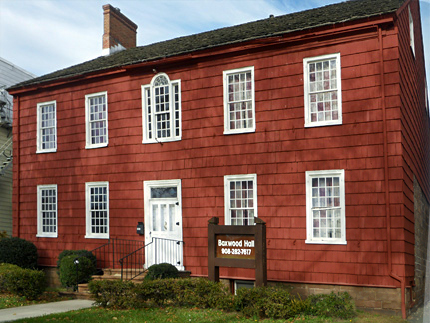
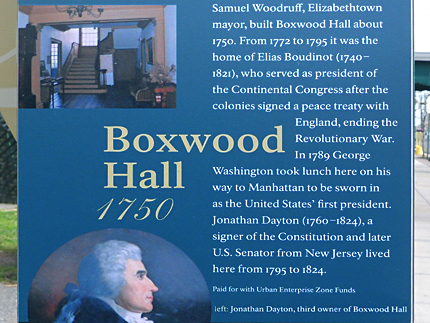
Boxwood Hall (Boudinot Mansion)
1073 East Jersey St.
Map / Directions to Boxwood Hall
Map / Directions to all Elizabeth Revolutionary War Sites
For current hours and admission information, see: https://www.facebook.com/BoxwoodHall
Boxwood Hall has a very interesting history that connects it with an early mayor of Elizabethtown, a President of the Continental Congress, the first President of the United States, the first Secretary of the Treasury, and three signers of the United States Constitution.
Boxwood Hall was built circa 1750 by Samuel Woodruff, who was then the Mayor of Elizabethtown. Elias Boudinot lived here from 1772 to 1795. [12] Boudinot (1740-1821) was a member of the Continental Congress, and served as the President of the Continental Congress in 1782-1783. It was during this time, on October 31, 1783, that word reached Congress, who were then meeting at Nassau Hall in Princeton, that the Treaty of Paris had been signed, officially ending the Revolutionary War. There are two other surviving New Jersey houses associated with Boudinot: one in Burlington and one in Chatham Township. Elias Boudinot is buried in St. Mary's Church Cemetery in Burlington.
When a young Alexander Hamilton studied in Elizabeth in 1773 at the Presbyterian Academy (see Site Of The Old Academy entry above on this page), he was a visitor at Boxwood Hall and developed a friendship with the Boudinots that would last his lifetime. [13] Hamilton fought in the Revolutionary War and served as an aide-de-camp to General Washington. He went on to serve under President Washington as the country's first Secretary of the Treasury, and his face is familiar to most people as it has appeared on the ten dollar bill since 1928. [14]
In April of 1789, George Washington traveled from his home in Virginia to be inaugurated as the country's first President in New York City, which then served as the national capital. Traveling north from Virginia, he reached New Jersey on April 21 at Trenton, where he was greeted by an elaborate reception under a Triumphal Arch. He continued on across New Jersey, and he reached Elizabethtown on April 23, 1789. Washington had lunch at Boxwood Hall before being ferried from Elizabethtown to New York City. This gives Elizabeth the distinction of being Washington's final stop before reaching the city where he would be sworn in as the first President. A monument honoring Washington's Inaugural stands in Winfield Scott Plaza about 100 yards from here. (See next entry.)
From 1795 to 1824, Jonathan Dayton lived at Boxwood Hall. [15] Dayton had served as a Lieutenant and Paymaster in the Revolutionary War. After the war, he was politically active in the affairs of the new nation. He was one of four men to sign the United States Constitution for New Jersey. He then served in the United States House of Representatives, including three years as Speaker of the House, and later in the United States Senate.
The other three New Jersey signers of the Constitution were:
~ David Brearly (Buried in St. Michael's Episcopal Church Cemetery in Trenton)
~ William Livingston (Built and lived in Liberty Hall in Union, also lived in the Livinston-Benedict house in Parsippany)
~ William Paterson (Paterson is named in his honor)
George Washington, who stopped at Boxwood Hall, also signed the Constitution, but he was a delegate for the state of Virginia. Alexander Hamilton, who had visited the house, signed the Constitution for the state of New York.
Boxwood Hall's connections to important Revolutionary War figures extends out as far as 1824, when General Lafayette stayed here overnight. General Lafayette was a French General who fought for the American side in the Revolutionary War. He developed close friendships with Washington, Hamilton, and other Revolutionary War figures. Decades after the end of the Revolutionary War, Lafayette made a return visit from France to the United States from August 16, 1824 - September 7, 1825. At that time, the United States consisted of only 24 states, and Lafayette visited all of them. On September 23, 1824, he visited Elizabethtown. Jonathan Dayton, who had known Lafayette during the Revolutionary War, acted as Grand Marshal of the day, while Lafayette received a tour of the city and was honored throughout the day. After a day of honors and salutes, Lafayette spent the night at Boxwood Hall. [16] Less than three weeks after the visit from Lafayette, Dayton died on Oct. 9, 1824. He is buried at St. John's Episcopal Church in Elizabeth. (See St. John's Episcopal Church entry below on this page.)
Other New Jersey historic sites associated with Lafayette's 1824/1825 visit to America can be found in Hackensack, Morristown, Newark, Paramus and Woodbridge.

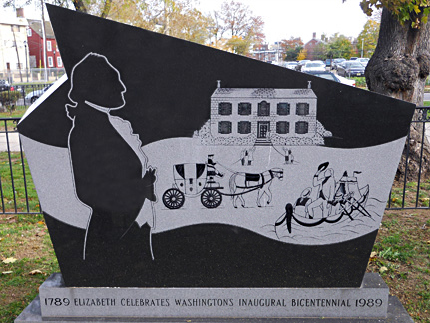
Washington Inaugural Monument
Winfield Scott Plaza
Site of General Winfield Scott House (Originally Dr. Barnet's House)
Map / Directions to Winfield Scott Plaza
Map Directions to all Elizabeth Revolutionary War Sites
The Washington Inaugural Monument commemorates Washington's April 23, 1789 stop in Elizabethtown, from where he was ferried to New York City, where he was sworn in as the First President of The United States. (New York City then served as the country's first capital).
The monument shows three scenes: Washington's carriage arriving, his entering Boxwood Hall where he had lunch, and then his being ferried away towards New York City. (See Boxwood Hall entry above) The monument was placed in 1989 on the Bicentennial of the Inauguration.
The Washington Inaugural Monument is located inside Winfield Scott Plaza, a small park named in honor of General Winfield Scott, known for his role in the Mexican War and the Civil War. His house stood nearby at 1105 E. Jersey Street. In the Revolutionary War era, this house had been the home of Dr. William Barnet, who served as a surgeon in the American Army. Barnet lived in the house from 1763 to 1790. The house was demolished in 1928. [17]
On February 10, 1780, a party of British soldiers entered Elizabethtown and plundered several houses, including Dr. Barnet's. Dr. Barnet is reported to have stated, "They emptied my feather beds in the streets, broke in windows, smashed my mirrors and left our pantry and storeroom department bare. I could forgive them all that, but the rascals stole from my kitchen wall the finest string of red peppers in all Elizabeth." Dr. Barnett died in 1790 and is buried in the Elizabeth First Presbyterian cemetery (see entry above on this page). [18]

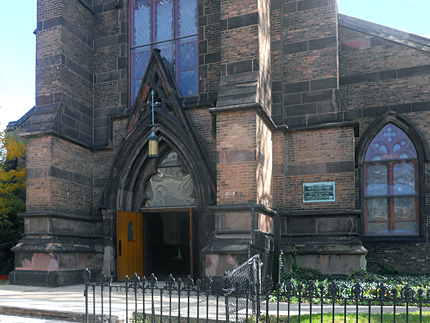
St. John's Episcopal Church
61 Broad St.
Map / Directions to Saint John's Episcopal Church
Map Directions to all Elizabeth Revolutionary War Sites
Jonathan Dayton, who lived at Boxwood Hall (see entry above on this page), is buried in an unmarked grave in this church's cemetery. Dayton had served as a lieutenant and paymaster in the Revolutionary War. In 1789, he was one of four signers of the United States Constitution for the state of New Jersey.
John DeHart, who served as a delegate from New Jersey at the First Continental Congress, is also buried here. After the war, he was elected the Mayor of Elizabeth, serving from 1789 until his death in 1795.

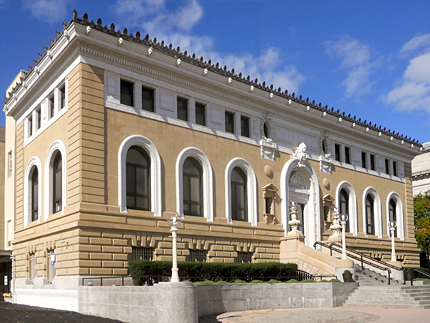
Elizabeth Public Library (Site of the Red Lion Inn)
11 S Broad St.
Map / Directions to the Elizabeth Public Library
Map Directions to all Elizabeth Revolutionary War Sites
The Elizabeth Public Library, which was built in 1912, stands at the site of the Red Lion Inn in the 1700's. The Inn, owned by Samuel Smith, was here during the Revolutionary War era. During the war, it was the site of at least one Court Martial, on March 8, 1779. [19] The Red Lion Inn survived the destructive January 25, 1780 raid of Elizabethtown, even though it was the next building along Broad Street after the Academy, Church and Courthouse, which were all burned.
On the morning of April 23, 1789, Washington stopped at the Red Lion Inn prior to his lunch at Boxwood Hall, before being ferried to New York City to be inaugurated the first President of the United States. (See Boxwood Hall entry above on this page.) There are no historical markers on the library building itself, but a historic sign about Elizabeth on the corner in front of the library does state, "In 1789, Washington was entertained here when the lot was the site of the Red Lion Inn, a popular lodging house and tavern during the Revolution." [20]

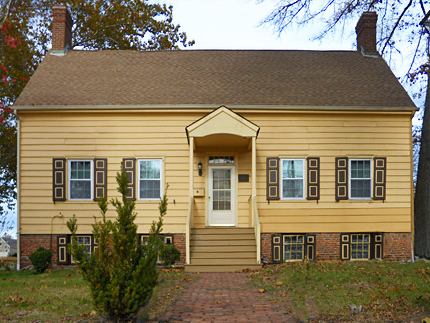
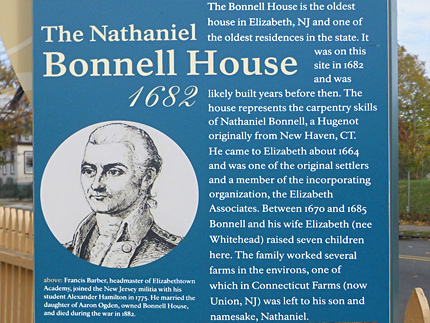
Bonnell House
Now used as the office of the Historical Society of Elizabeth NJ
1045 East Jersey Avenue
Map / Directions to the Bonnell House
Map Directions to all Elizabeth Revolutionary War Sites
Colonel Francis Barber (detailed in the Site of the Old Academy entry above on this page) lived with his wife Mary at this house, which is the oldest in Elizabeth. The house takes its name from Nathaniel Bonnell, the man who built it in 1682. [21]

1. ^ John F. Snyder, The Story of New Jersey's Civil Boundaries: 1606-1968 (Trenton: Bureau of Geology and Topography, 1969) p. 237-242 Available as a PDF on the State of New Jersey website here.
2. ^ Information about the burning of the church from the plaque on the building.
Source notes for the other information about the Caldwell's can be found on the town pages linked to in this entry's text.3. ^ Plaque on the church, erected by the Elizabethtown Chapter, No. 1, Sons of the American Revolution, October 19, 1898.
4. ^ Soldier information was drawn primarily from the document, Veterans Tombstones in First Presbyterian Church (Founded 1664) (Robert A Reynolds, May 2006), which is available as a PDF on the First Presbyterian Church of Elizabeth NJ website here
From there, additional information (such as military information) was added from, and crosschecked with, gravestones in the cemetery.
5. ^ Ron Chernow, Alexander Hamilton (New York: The Penguin Group, 2004) p.42-43
and
Nancy Isenberg, Fallen Founder - The Life of Aaron Burr (New York: Viking, 2007) p.8-9
• Both biographers, Chernow and Isenberg, conclude the possibility or probability of Hamilton and Burr having met in Elizabethtown in 1773.
~ Isenberg writes, "It was in Elizabethtown that Burr may have first crossed paths with his future political rival Hamilton. Both spent time there in 1773." (Fallen Founder, page 9)
~ Chernow writes, "Hamilton's attendance at the Elizabethtown Academy brought him into the immediate vicinity of the younger Aaron Burr, who had attended the same school several years earlier... By a remarkable coincidence, Burr spent the summer of 1773 in Elizabethtown, right around the time Hamilton arrived. Hamilton might have seen this handsome, genial young man sauntering down the street, gliding by in a boat along the town's many inlets, or hunting in the nearby woods. As we shall see, they probably also met in the drawing room of mutual friends." (Alexander Hamilton, page 43)6. ^ William S. Stryker, Official Register of the Officers and Men of New Jersey in the Revolutionary War (Trenton: Wm. T. Nicholson & Co., 1872) p. 65 Available to be read at the Internet Archive here
7. ^ The story of Colonel Barber's death, and the quote attributed to Washington, appear in several books, including:
• F. W. Ricord, Editor, History of Union County, New Jersey, Volume 1(Newark NJ; East Jersey History Company, 1897) p.45. A 2001 Heritage Books facsimile reprint is available at Google Books here.
• Report of the Valley Forge Revolutionary Encampment Commission of the State of New Jersey (Camden NJ: Sinnickson Chew & Sons Company, 1916) p. 50. Available to be read at Google Books here
• James Madison Drake, Historical sketches of the Revolutionary and Civil Wars (New York: Webster Press, 1908) p. 87. Available to be read at Google Books here
Each of these three accounts are similar, with some variation in detail. It is sometimes stated that Washington had heard news of the signing of the peace treaty on that day, which was why he had invited officers to dine with him. Unfortunately, none of these books lists a source for their information, and more specifically, for the Washington quote. I was unable to locate a primary or contemporary source that records that Washington said "Men of higher rank and more wealth may die, but there is but one Francis Barber." I personally find it questionable that he said it, which is why in the entry I wrote, "is reported to have said..."
8. ^ Historic sign in front of the Union County Courthouse
9. ^ The claim that this is the only seal in the country which depicts a killing appears in various publications and articles. I could not locate anything written in depth on the subject. However, given how unusual it is to have a killing depicted on even this one seal, it seems quite probable that there isn't another seal in the country depicting a killing.
10. ^ Plaque erected by the Elizabethtown Chapter, No. 1, Sons of the American Revolution, December 2, 1905
11. ^ Thomas Fleming, The Forgotten Victory (New York: Reader's Digest Press, distributed by E. P. Dutton & Co., Inc, 1973) p. 95-99
• Fleming's book was my main source of information for the Battle of Connecticut Farms and the Battle of Springfield. The book is recommended to those looking for an in-depth account of the battles.
• Fleming also created a condensed version of his book, which was published in 1974 as a booklet called The Battle of Springfield. The booklet was number eight of a twenty-eight booklet series called New Jersey's Revolutionary Experience, published by the New Jersey Historical Commission to commemorate the Bicentennial. A PDF of The Battle of Springfield booklet is available on the New Jersey State Library website here.12. ^ Information in this entry about Samuel Woodruff, Elisa Boudinot, and Jonathan Dayton connections to Boxwood Hall was drawn from the historic sign in front of Boxwood Hall.
Source notes for other details in this entry can be found on the other town pages linked to from within the Boxwood Hall entry text.13. ^ Ron Chernow, Alexander Hamilton (New York: The Penguin Group, 2004) p.45
14. ^ Hamilton first appearing on the $10 bill in 1928 was drawn from:
Currency Notes booklet, Bureau of Engraving and Printing - Available as a PDF on the website of the Bureau of Engraving and Printing, U.S. Department of the Treasury Here15. ^ Historic sign in front of Boxwood Hall
16. ^ September 28, 1824 article that appeared in the New Jersey Journal and Elizabethtown Gazette, and reprinted in
History of Freemasonry in Elizabeth, N.J (Elizabeth, NJ: Drake & Cook, 1875) p. 18 -20 Available to be read at Google Books here17. ^ The Federal Writers' Project of the Works Progress Administration for the State of New Jersey New Jersey A Guide to its Present and Past ( Newark: Viking Press, 1939) p.245-246. Available to be read at Google Books here
18. ^ A report of the raiding party appeared a week later in the N.J. Gazette, Vol. III,No. 112, Feb. 16, 1780, reprinted in:
William Nelson, Editor, Archives of the State of New Jersey, Second Series, Vol. IV Extracts From American Newspapers Relating to New Jersey, Nov. 1, 1779 - Sept. 30, 1780 (Trenton: State Gazette Publishing Co., 1914) p. 182-183
Available to be read at the Internet Archive hereThe "They emptied my feather beds..." quote appears in several publications, including the New Jersey A Guide to its Present and Past book noted in Source note 17, but I have been unable to find anything noting its original source. The earliest time I was able to find it quoted was in 1915:
Sarah Comstock Old Roads from the Heart of New York (New York and London: G. P. Putnam's Sons, 1915) p. 157
Available at the Internet Archive hereOn the one hand, the quote sounds like it could have been some later writer's invention (which often happened in writings during the 1800's and early 1900's).
On the other hand, I absolutely love this quote, so I would very much like to believe that it is authentic.19. ^ George Washington's General Orders for Friday, March 5, 1779, issued from his Middle Brook Headquarters state, "The Court Martial of which Colonel Williams is President is adjourned to Elizabethtown to meet at Smith's Tavern on monday next at ten oClock"
George Washington, Edited by John Clement Fitzpatrick, The Writings of George Washington from the Original Manuscript Sources, 1745-1799 / Volume 14: January 12, 1779 - May 5, 1779 (Washington D.C.: George Washington Bicentennial Commission, U.S. Government Printing Office, 1779) p. 193 Available to be read at Google Books here20. ^ "Elizabeth New Jersey" historic sign in front Elizabeth Public Library.
21. ^ Text of the historic sign in front of the Bonnell House; and the "Elizabeth Through The Ages" timeline on the Elizabeth Historical Society website